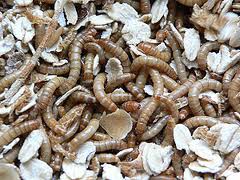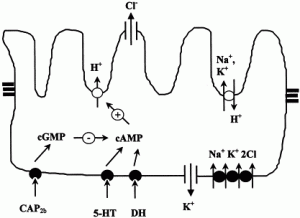In insects, the regulation of water balance is of critical importance in maintaining homeostasis [1]. Homeostasis is the state of relative stability of the internal environment of an organism. One of the main processes involved in the control of water balance is diuresis. Diuresis is the elimination of excess water in the form of urine. This secretion takes place within the excretory system of the insect, which includes the Malpighian tubules and the hindgut [Figure 1]. Excretion and water balance are under neuroendocrine control [2]. The hormones involved in the process of diuresis are called diuretic hormones (DH). They are responsible for stimulating the secretion of urine by the Malpighian tubules. There are three primary diuretic hormones found in insects: CRF-like diuretic hormones, kinins, and serotonin [3].
Insect diuretic hormones play key roles in the regulation of water balance. They are generally released in response to feeding, which involves a large uptake of water. This is particularly important for blood-eating insects, such as Rhodnius prolixus (blood-sucking bug) and Aedes aegypti (yellow fever mosquito), which can consume up to 10-20X their body weight during a single meal [2].
Of the three main insect diuretic hormones, two are classified as neuropeptides (CRF-like DH and kinins) and one as a neurotransmitter  (serotonin, 5-HT). All three stimulate the secretion of urine by the Malpighian tubules, but each has its own way of mediating this excretion. When presented together, these diuretic hormones can act in synergism to further enhance the process of diuresis [3].
(serotonin, 5-HT). All three stimulate the secretion of urine by the Malpighian tubules, but each has its own way of mediating this excretion. When presented together, these diuretic hormones can act in synergism to further enhance the process of diuresis [3].
CRF-like diuretic hormones, which are similar to the vertebrate CRF, mediate the secretion of urine through the production of cyclic AMP. These cAMP act as secondary messengers to mediate the secretion of urine by the Malpighian tubules. The CRF-like DH via cAMP, promotes the active transport of Na+ and K+ ions into the Malpighian tubule lumen. This transport of ions from the hemolymph (blood analogue for insects) to the tubule lumen is the driving force for the secretion of urine [4]. Although CRF-like DH is present in the majority of insects, each species of insects may have its own specific CRF-like DH. Some examples of CRF-like DH include: Locusta-DH in locusts, Acheta-DH in crickets, Stomoxys-DH and Musca-DH in flies, Periplaneta-DH in cockroaches, and Manduca-DH in moths. In addition, some species of insects possess two CRF-like DH, such as Manduca sexta, which has Manduca-DH I and Manduca-DH II [6].
The insect kinin family of neuropeptides is another type of diuretic hormone found in the majority of insects. Like CRF-related DH, kinins also stimulate the secretion of urine. However, unlike CRF-related DH which act via cAMP, kinins mediate the excretion of urine by increasing the levels of intracellular Ca2+[5]. Some examples of insect kinins include: leucokinins in Leucophaea maderae (cockroach), achetakinins in Acheta domesticus (cricket), and locustakinins in Locusta migratoria (locust) [7].
Unlike the other two diuretic peptides, serotonin (5-HT or 5-Hydroxytryptamine) is a neurotransmitter that functions as a hormone and is found in only some species of insects. One of these species is the blood-sucking bug, Rhodnius prolixus, which has both a CRF-like neuropeptide and serotonin. Although serotonin can stimulate urine secretion by the Malpighian tubules, it still requires a diuretic peptide (CRF-like DH or kinins) for maximal secretion [8]. When present, serotonin is the second diuretic hormone which acts synergistically with diuretic peptides to produce urine excretion [9].
Whether it involves a kinin and a CRF-like DH, or a CRF-like DH and serotonin, the synergistic control of Malpighian tubule secretion results in a number of advantages. When two diuretic hormones act together, the increase in tubule secretion is greater than the sum of their separate responses. This synergistic effect reduces the amount of diuretic hormones needed to induce the desired urine secretion [9]. This is observed in locusts, where maximal tubule secretion requires 50% of the insect’s stored CRF-like DH (Locusta-DH). However, in the presence of a kinin (locustakinin), only 2.5% of the locust’s stored Locusta-DH is required for maximum tubule excretion [10]. Another advantage of synergism is the speed with which tubule secretion can be turned on and off. This is because it requires only a small change in the concentration of either diuretic hormone to significantly influence tubule function [9].
Individually, each diuretic hormone has a different effect on the rate of tubule secretion. Kinins generally give a response that is 30-75% of that produced by a CRF-like DH from the same insect [11]. One effective method used to determine the rate of tubule secretion as well as the composition of that secretion is the Ramsay Assay.
This assay is the main technique used to measure the effects of diuretic hormones on the fluid secretion rate of the Malpighian tubules. The Malpighian tubules arise from the midgut-hindgut junction, and they generally float freely within the abdomen cavity which is surrounded by hemolymph [Figure 1]. In the Ramsay assay, a single tubule is isolated and severed from its connection to the gut. The free-floating end of the tubule (farthest from the gut) is placed in a Ringer solution, while the severed end is put into an oil bath solution. Secretion from the severed end accumulates as a droplet in the oil bath, and this droplet is then measured to yield the fluid secretion rate. X-ray spectroscopy is then  administered to identify the secreted elements of the fluid [4].
administered to identify the secreted elements of the fluid [4].
One important aspect regarding the insect excretory system is that it is coupled with the movement of ions. Tubule secretion of urine is driven by the active and/or passive transport of Na+, K+, and Cl– ions from the hemolymph into the tubule lumen.
Diuretic hormones increase the rate of tubule secretion by stimulating this ion movement. CRF-like DH does this via cAMP as a secondary messenger. Kinins, on the other hand, increases intracellular Ca2+ to stimulate ion transport. Both responses have different effects on the ion transport processes and the composition of the excreted urine [4]. Through cAMP, CRF-like DH opens Na+ channels on the tubules, thereby increasing the Na+ concentration in urine. This pathway is especially significant in blood-feeding insects because blood is rich in NaCl [12]. In contrast, kinins causes the urine concentration of Na+ to fall and the K+ concentration to increase [13]. This is particularly important in plant-feeding insects such as locusts and moths, which consume a diet rich in K+ with relatively little Na+[12]. Another difference between CRF-like DH and kinins is that CRF-like DH stimulates the active transport of cations (Na+; K+) while kinins stimulate the passive transport of anions (Cl–) [4].
References:
[1] Phillips, JE and J. Hanrahan. Mechanisms and control of reabsorption in insect hindgut. Advance Insect Physiology 19 (1986) 329-422.
[2] Coast, G.M. Diuresis in the housefly (Musca domestica) and its control by neuropeptides. Peptides 22 (2001) 153-160.
[3] O’Donnell M.J. and J.H. Spring. Modes of control of insect Malpighian tubules: synergism, antagonism, cooperation and autonomous regulation. Journal of Insect Physiology 46 (2000) 107-117.
[4] Beyenbach, K.W. Mechanism and Regulation of Electrolyte Transport in Malpighian Tubules. Journal of Insect Physiology 41 (1995) 197-207.
[5] Furuya, Kenji et al. Cockroach diuretic hormones: Characterization of a calcitonin-like peptide in insects. Biochemistry 97 (2000) 6469-6474.
[6] Kay, I., and G.M. Coast. Isolation and characterization of a diuretic peptide from Acheta domesticus: Evidence for a family of insect diuretic peptides. Biol. Chemistry 372 (1991) 505-512.
[7] Veenstra, J.A. Isolation and identification of 3 leucokinins from the mosquito Aedes aegypti. Biochem. Biophys. Res. Commun. 202 (1994) 715-719.
[8] Maddrell, S.H.P., and W.S. Herman. 5-Hydroxytryptamine: A second diuretic hormone in Rhodnius. Journal of Experimental Biology 156 (1991) 557-566.
[9] Maddrell, S.H.P, and B.O. Gardiner. Synergism of hormones controlling epithelial fluid transport in an insect. Journal of Experimental Biology 174 (1993) 65-80.
[10] Patel, M., and G.M. Coast. Evidence for the hormonal function of a CRF-related diuretic peptide (Locusta-DP) in Locusta migratoria. Journal of Experimental Biology 198 (1995) 793-804.
[11] Coast, G.M., and G.M. Holman. The diuretic activity of a series of cephalomyotropic neuropeptides, the achetakinins, on isolated Malpighian tubules of the house cricket, Acheta domesticus. Journal of Insect Physiology 36 (1990) 481-488.
[12] Williams, J.C. Jr., and K.W. Beyenbach. Differential effects of secretagogues on Na and K secretion in Malpighian tubules of Aedex aegypti. Journal of Comparative Physiology 149 (1983) 511-517.
[13] Pannabecker, T.L., and K.W. Beyenbach. Regulation of epithelial shunt conductance by the peptide leucokinin. J. Membr. Biology. 132 (1992) 63-76.
